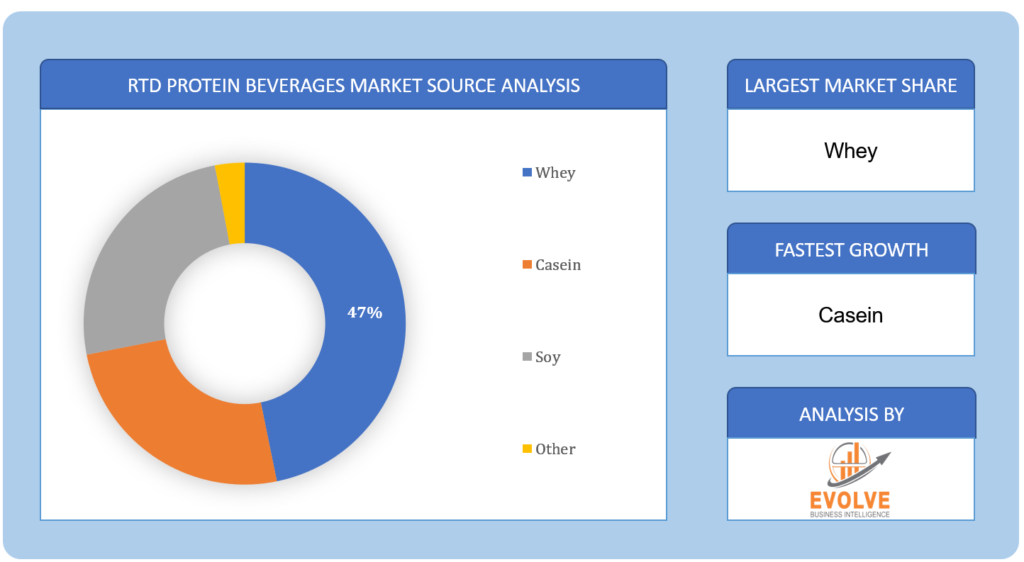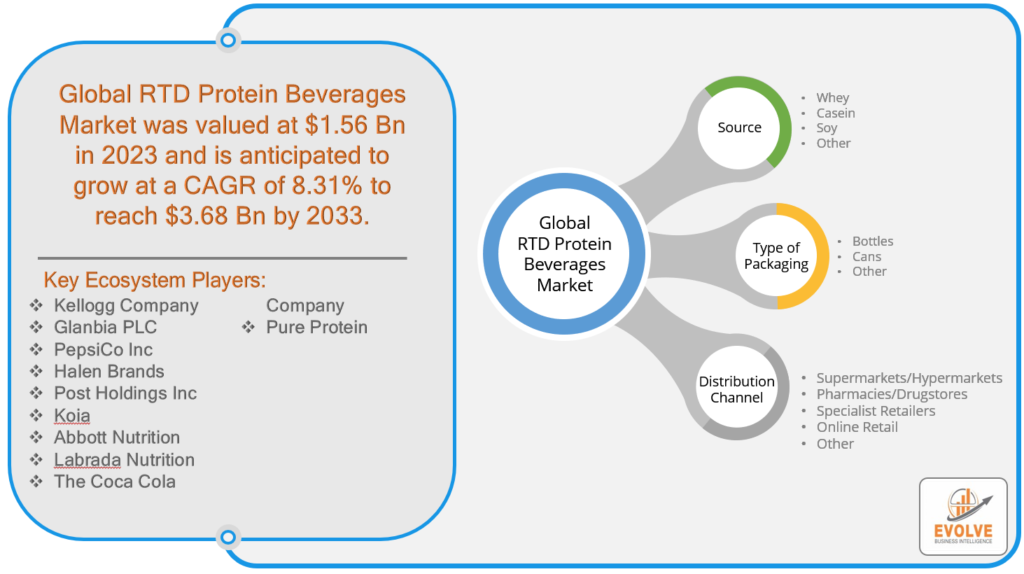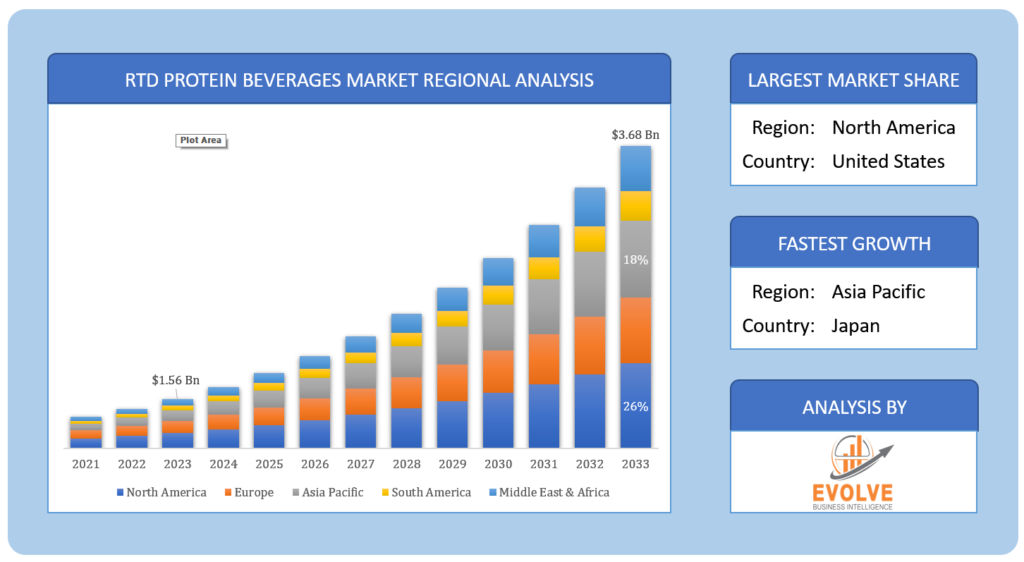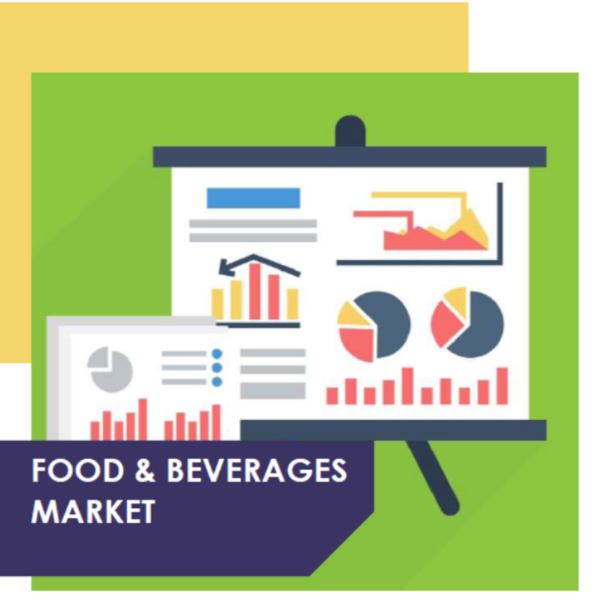RTD Protein Beverages Market Overview
The RTD Protein Beverages Market Size is expected to reach USD 3.68 Billion by 2033. The RTD Protein Beverages industry size accounted for USD 1.56 Billion in 2023 and is expected to expand at a compound annual growth rate (CAGR) of 8.31% from 2023 to 2033. RTD Protein Beverages, also known as Ready-to-Drink Protein Beverages, are pre-packaged beverages that contain a significant amount of protein and are ready for immediate consumption without any additional preparation. These beverages are designed to provide a convenient and portable source of protein for consumers who lead active lifestyles or seek a quick and easy way to supplement their protein intake. RTD Protein Beverages typically come in various flavors and formulations, including whey protein, plant-based protein (such as soy, pea, or hemp protein), or a combination of protein sources. They are popular among fitness enthusiasts, athletes, and individuals looking to support muscle recovery, promote satiety, or meet their daily protein requirements on the go. Additionally, some RTD Protein Beverages may include other functional ingredients like vitamins, minerals, and amino acids to enhance their nutritional profile.
Global RTD Protein Beverages Market Synopsis
The COVID-19 pandemic had a profound and lasting impact on the RTD Protein Beverages market. As governments imposed lockdowns and restrictions to curb the virus’s spread, there was a significant shift in consumer behavior toward health and wellness. With more people working from home and prioritizing immune system support, the demand for convenient and nutritious RTD Protein Beverages surged. Fitness enthusiasts and individuals seeking alternative protein sources also contributed to the market growth. Furthermore, the pandemic accelerated the adoption of e-commerce platforms for food and beverage purchases, enabling consumers to access RTD Protein Beverages easily. As the pandemic prompted a lasting focus on personal health, the RTD Protein Beverages market witnessed sustained growth and adaptation to changing consumer preferences.
Global RTD Protein Beverages Market Dynamics
The major factors that have impacted the growth of RTD Protein Beverages are as follows:
Drivers:
⮚ Growing Health and Wellness Consciousness
One significant driver of the RTD Protein Beverages market is the increasing awareness and focus on health and wellness among consumers. As people become more health-conscious and seek convenient ways to incorporate essential nutrients into their diets, RTD Protein Beverages offer a convenient and accessible source of protein. The perception of protein as a vital component for muscle recovery, weight management, and overall well-being has fueled the demand for these beverages, especially among fitness enthusiasts, athletes, and health-conscious individuals.
Restraint:
- Competitive Landscape and Pricing Pressure
The RTD Protein Beverages market faces intense competition from various players, including well-established beverage companies and new entrants. As a result, manufacturers often experience pricing pressure to remain competitive, especially in the mass-market segment. This competitive landscape may lead to reduced profit margins and limited opportunities for smaller companies to establish a strong foothold. Additionally, pricing sensitivity among price-conscious consumers could also hinder market growth, as they may opt for cheaper alternatives or traditional sources of protein.
Opportunity:
Innovations in Formulations and Flavors
An opportunity for the RTD Protein Beverages market lies in continuous innovation in formulations and flavors. Manufacturers can cater to diverse consumer preferences and dietary requirements by offering a wide range of options, including plant-based protein beverages for vegans and vegetarians, or specialized products for specific dietary needs. Furthermore, incorporating additional functional ingredients like vitamins, minerals, and adaptogens can enhance the appeal of RTD Protein Beverages, attracting health-conscious consumers seeking more comprehensive nutritional benefits. Innovations in packaging and sustainability initiatives can also contribute to attracting environmentally conscious consumers and driving further market growth.
RTD Protein Beverages Market Segment Overview
By Source
 Based on the Source, the market is segmented based on Whey, Casein, Soy, and Others. The Whey segment was projected to hold the largest market share in the RTD Protein Beverages market due to its popularity and wide acceptance as a complete and high-quality protein source.
Based on the Source, the market is segmented based on Whey, Casein, Soy, and Others. The Whey segment was projected to hold the largest market share in the RTD Protein Beverages market due to its popularity and wide acceptance as a complete and high-quality protein source.
By Type of Packaging
Based on the Type of Packaging, the market has been divided into Bottles, Cans, and Others. The Bottles segment is expected to hold the largest market share in the RTD Protein Beverages market due to its convenience and portability, catering to the on-the-go lifestyle of consumers.
By Distribution Channel
Based on Distribution Channel, the market has been divided into Supermarkets/Hypermarkets, Pharmacies/Drugstores, Specialist Retailers, Online Retail, Other. The Supermarkets/Hypermarkets segment is expected to hold the largest market share in the RTD Protein Beverages market due to their extensive distribution networks, offering a wide range of products, and being preferred shopping destinations for consumers seeking convenience and variety.
Global RTD Protein Beverages Market Regional Analysis
Based on region, the market has been divided into North America, Europe, Asia-Pacific, the Middle East & Africa, and Latin America. The area of North America is anticipated to dominate the market for the usage of RTD Protein Beverages, followed by those in Asia-Pacific and Europe.
 RTD Protein Beverages North America Market
RTD Protein Beverages North America Market
North America has consistently maintained a significant market share in the RTD Protein Beverages market, establishing itself as a key player in the industry. This dominance can be attributed to several factors, including the region’s strong health and fitness culture, growing awareness of the importance of protein intake, and the increasing adoption of convenient and on-the-go nutrition options. The presence of well-established and innovative beverage companies in North America has also contributed to the steady growth of the RTD Protein Beverages market in the region. Additionally, favorable consumer preferences for a wide variety of flavors and formulations, along with robust distribution networks in supermarkets, convenience stores, and online platforms, have further fueled the demand for RTD Protein Beverages in North America, solidifying its leading position in the market.
RTD Protein Beverages Asia Pacific Market
The RTD Protein Beverages industry in the Asia-Pacific region has been witnessing remarkable growth in recent years. This surge can be attributed to various factors, including the region’s burgeoning population, rising disposable incomes, and an increasing focus on health and wellness. As urbanization and hectic lifestyles become more prevalent, there is a growing demand for convenient and ready-to-drink beverages that provide a quick and accessible source of protein. Additionally, the growing influence of Western dietary trends, coupled with the adoption of fitness and health-conscious habits, has contributed to the popularity of RTD Protein Beverages among consumers in countries like China, India, Japan, and Southeast Asian nations. Multinational beverage companies, as well as local players, have recognized the potential of this market and have been actively expanding their product offerings and distribution networks to cater to the diverse preferences of consumers in the Asia-Pacific region.
Competitive Landscape
The competitive landscape includes key players (tier 1, tier 2, and local) having a presence across the globe. Companies such as Kellogg Company, Glanbia PLC, PepsiCo Inc, Halen Brands, and Post Holdings Inc are some of the leading players in the global RTD Protein Beverages Industry. These players have adopted partnership, acquisition, expansion, and new product development, among others as their key strategies.
Key Market Players:
- Kellogg Company
- Glanbia PLC
- PepsiCo Inc
- Halen Brands
- Post Holdings Inc
- Koia
- Abbott Nutrition
- Labrada Nutrition
- The Coca-Cola Company
- Pure Protein
Key development:
In March 2022, QNT SA and Qimia Makmal Arad Company forged a partnership, allowing Qimia to be the authorized distributor of QNT’s functional foods, supplements, and sports nutrition products in Iran.
In February 2022, Optimum Nutrition unveiled a new standalone Ready-to-Drink (RTD) protein supplement in the UK, distinct from the company’s existing Gold Standard RTD Protein product.
Scope of the Report
Global RTD Protein Beverages Market, by Source
- Whey
- Casein
- Soy
- Other
Global RTD Protein Beverages Market, by Type of Packaging
- Bottles
- Cans
- Other
Global RTD Protein Beverages Market, by Distribution Channel
- Supermarkets/Hypermarkets
- Pharmacies/Drugstores
- Specialist Retailers
- Online Retail
- Other
Global RTD Protein Beverages Market, by Region
- North America
- US
- Canada
- Mexico
- Europe
- UK
- Germany
- France
- Italy
- Spain
- Benelux
- Nordic
- Rest of Europe
- Asia Pacific
- China
- Japan
- South Korea
- Indonesia
- Austalia
- Malaysia
- India
- Rest of Asia Pacific
- South America
- Brazil
- Argentina
- Rest of South America
- Middle East & Africa
- Saudi Arabia
- UAE
- Egypt
- South Africa
- Rest of Middle East & Africa
| Parameters | Indicators |
|---|---|
| Market Size | 2033: $3.68 Billion |
| CAGR | 8.31% CAGR (2023-2033) |
| Base year | 2022 |
| Forecast Period | 2023-2033 |
| Historical Data | 2021 |
| Report Coverage | Revenue Forecast, Competitive Landscape, Growth Factors, and Trends |
| Key Segmentations | Source, Type of Packaging, Distribution Channel |
| Geographies Covered | North America, Europe, Asia-Pacific, Latin America, Middle East, Africa |
| Key Vendors | Kellogg Company, Glanbia PLC, PepsiCo Inc, Halen Brands, Post Holdings Inc, Koia, Abbott Nutrition, Labrada Nutrition, The Coca-Cola Company, Pure Protein |
| Key Market Opportunities | • Market Expansion in Emerging Economies • Innovations in Formulations and Flavors |
| Key Market Drivers | • Increasing Health and Wellness Awareness • Growing Health and Wellness Consciousness |
REPORT CONTENT BRIEF:
- High-level analysis of the current and future RTD Protein Beverages Industry trends and opportunities
- Detailed analysis of current market drivers, restraining factors, and opportunities analysis in the future
- Historical market size for the year 2021, and forecast from 2023 to 2033
- RTD Protein Beverages market share analysis for each segment
- Competitor analysis with a comprehensive insight into its product segment, financial strength, and strategies adopted.
- Identifies key strategies adopted by the key players including new product development, mergers and acquisitions, joint ventures, collaborations, and partnerships.
- To identify and understand the various factors involved in the global RTD Protein Beverages market affected by the pandemic
- To provide year-on-year growth from 2022 to 2033
- To provide short-term, long-term, and overall CAGR comparison from 2022 to 2033.
- Provide Total Addressable Market (TAM) for the Global RTD Protein Beverages Market.








